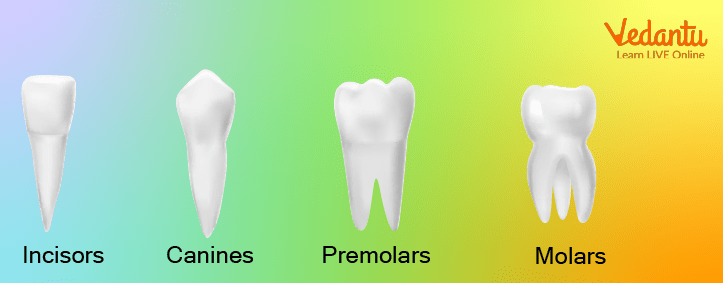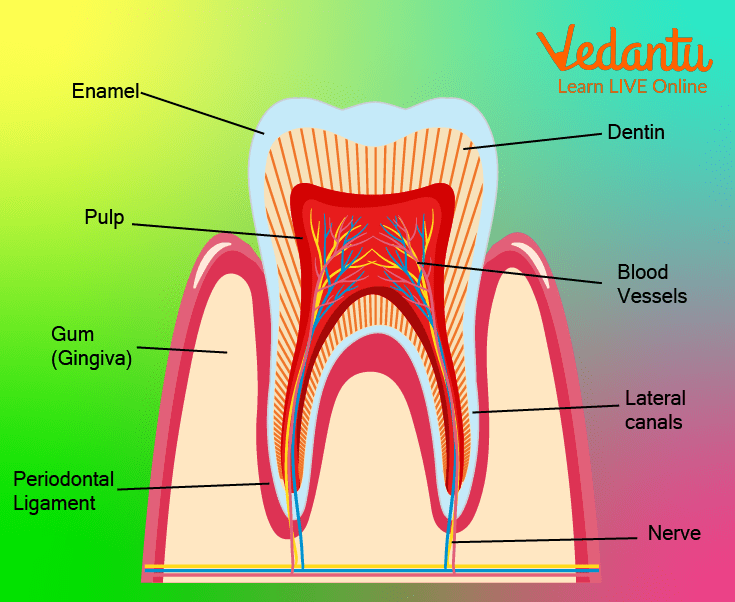




Introduction About Teeth
Many vertebrates, or animals with spines, have teeth inside their mouths. Teeth are hard, bony designs that develop from the jawbone. People and different animals use their teeth to chew and bite food.
We will get to learn about types of teeth for kids. By cutting, tearing, and crushing food and by the help of mixing it in with saliva, teeth do the most important part in the digestion of food that we eat. This is known as mastication. The teeth of people likewise help in speaking and producing sound, and they also make us look beautiful.
Teeth for kids are of various shapes and do different work. Chisel-shaped incisors, the front teeth in the human mouth, help to bite and cut food. The sharp cuspids, the canine teeth, are used for tearing and destroying. Bicuspids are double-pointed teeth and help to tear and crush food. Molars have broad surfaces for grinding and crushing our food. We will look into all sets of teeth.
Types of Teeth
Teeth of various shapes do various positions. Front teeth, called incisors, bite and cut. Pointed teeth, called cuspids or canines, tear and shred. Teeth with two cusps, called bicuspids, tear, and crush. Back teeth, called molars, grind and crush. In the same way as other different warm-blooded animals, people have two arrangements of teeth during their lives.
How Many Teeth does a Child have?
The primary set comprises 20 teeth. These are called primary, or child, teeth. At the point when a kid is around 6 years of age, these teeth start to lose and drop out. Throughout the following eight years 28 permanent teeth supplant all the child teeth. These are a set of teeth a human being has. At the point when an individual is around age 20, four additional molars, called wisdom teeth, come in. Many individuals have their wisdom teeth eliminated to keep their different teeth straight. This justifies how many teeths does a child have.

Types of Human Teeth
Tooth Structure
The visible piece of a tooth is known as the crown. A few layers make up the crown. The external layer is a hard white covering called enamel. Enamel safeguards the tooth from destroying. Underneath the enamel is dentin. This yellow, bone-like material is softer than enamel. Dentin makes up the biggest piece of the tooth.
The centre point of a tooth is known as the pulp. The pulp is a delicate tissue that contains blood and nerves. Nerves in the teeth convey messages to the cerebrum about intensity, cold, or pain.
The delicate tissue around the base of every tooth is known as the gum. The roots of the teeth lie beneath the gums. A tooth has somewhere in the range of one and three roots. A glue-like substance called cementum covers the roots. The cementum keeps the teeth intact in the jawbone. Have a look at a simple teeth diagram. Types of teeth are explained below.

Simple Teeth Diagram
Problems with Teeth
A typical issue with teeth is tooth rot or holes. Microscopic organisms in the mouth structure a tacky film called plaque. As plaque develops on the teeth, it destroys the tooth enamel. The loss of enamel, called a cavity, may cause pain and disease.
Teeth in Other Animals
The teeth of all vertebrates are approx. same, however, the shape of the crown and root fluctuates among various animals. Numerous animals have teeth that are adjusted for extraordinary purposes. Rodents, bunnies, and rabbits have bent incisors that are set profoundly inside the jaw and develop persistently.
Primates have extended canines that they use for protection and show. Snake teeth are empty teeth that carry on like needles through which they convey toxins.
Summary
Look into your mouth and observe all types of teeth you have. Count how many teeth are there in your mouth. Learn the use of all different types of teeth. You can also observe your friend's tooth.
Dental specialists fill cavities with metal or plastic to forestall further harm. Plaque can likewise make gums red, sore, and frail. Over the long run, weakened gums can wear out up to the point that the teeth drop out. Regular tooth brushing, flossing, and visits to a dental specialist can solve these issues.
The tusks of elephants are augmented upper incisors. The tusks of walruses and wild hogs are extended canines.
FAQs on Teeth for Kids
1. How many teeth does a child have, and what are they called?
Children have a first set of 20 teeth, which are commonly called milk teeth or primary teeth. This set includes incisors, canines, and molars. These teeth start appearing when a baby is around 6 months old and are usually all in place by the age of 3.
2. What are the four main types of teeth and what do they do?
The four main types of teeth help us bite, tear, and chew our food. Their functions are:
- Incisors: These are the eight sharp, flat teeth at the front of your mouth (four on top, four on bottom) used for biting into food.
- Canines: These are the four pointy teeth next to the incisors. They are used for tearing food, like meat.
- Premolars: Found next to the canines, these teeth have a flat top and are used for crushing and grinding food. Children do not have premolars; they appear in the permanent set.
- Molars: These are the large, strong teeth at the back of the mouth. Kids have eight molars, which are used for grinding food into small pieces before swallowing.
3. Why do we have two sets of teeth in our lifetime?
We have two sets of teeth to match the size of our jaws as we grow. A child's jaw is small, so it can only fit the smaller milk teeth. As we grow into adults, our jaws become larger, creating space for a bigger set of 32 permanent teeth. The milk teeth fall out to make way for these stronger, larger permanent teeth that are designed to last a lifetime.
4. At what age do children start losing their milk teeth?
Children typically start losing their milk teeth around the age of 6 or 7. The process starts with the front teeth (incisors) and continues until about age 12 or 13. As each milk tooth becomes loose and falls out, a permanent tooth grows in its place.
5. What is the main difference between milk teeth and permanent teeth?
The main differences between milk teeth and permanent teeth are their number, size, and strength. A child has 20 milk teeth, while an adult has 32 permanent teeth. Permanent teeth are larger, stronger, and have a thicker layer of enamel, making them more durable for a lifetime of use. Milk teeth are smaller and whiter, serving as placeholders for the adult teeth to come.
6. Why is it important to take care of milk teeth even though they will fall out?
Taking care of milk teeth is very important for several reasons. Healthy milk teeth help children chew properly and speak clearly. They also act as space-savers in the jaw, guiding the permanent teeth into their correct positions. If a milk tooth is lost too early due to decay, it can cause crowding or alignment problems for the permanent teeth that follow.
7. How are the different teeth arranged in a child's mouth?
In a child's mouth, the 20 milk teeth are arranged symmetrically. In each jaw (upper and lower), you will find: four incisors at the very front for biting, flanked by two canines (one on each side) for tearing. Behind the canines are four molars (two on each side) for grinding food. This arrangement ensures that different teeth can work together efficiently to process food.
8. Can you explain the basic parts of a tooth in simple terms?
A tooth has two main parts: the crown and the root. The crown is the visible part you see in your mouth. The root is the part hidden below the gums that holds the tooth in the jawbone. The crown is covered by enamel, a very hard, white substance that protects the tooth from cavities. Under the enamel is the dentin, a sensitive, bone-like layer that makes up most of the tooth.









